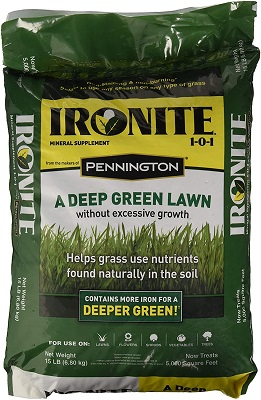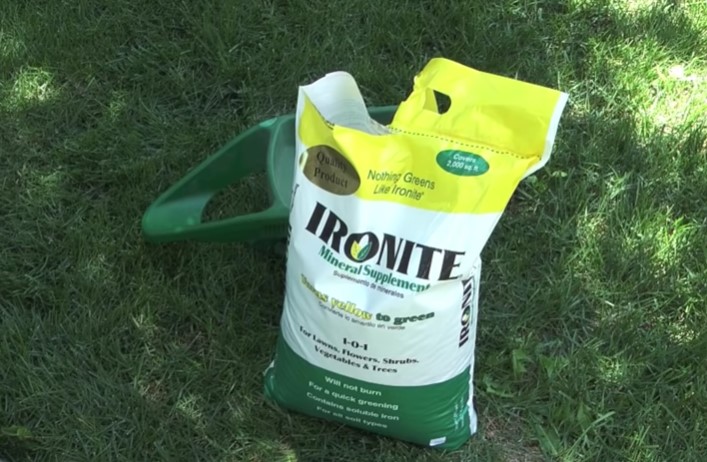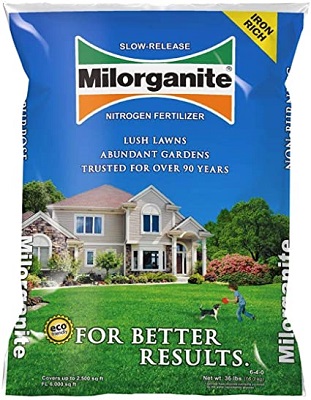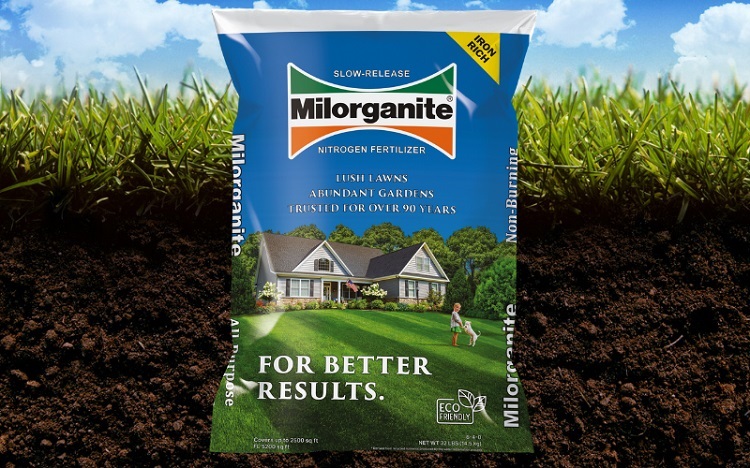- Popular Types of Bermuda Grass Explained - April 21, 2022
- When to Mow New Grass - April 18, 2022
- Best Troy Bilt Push Mower: How to Find The Right One - April 25, 2021
If you’re an avid gardener, then you already know that Ironite vs Milorganite are two of the most common supplements to keep the grass on your lawn looking green all year round. But, what are their main differences and how do they stack up against each other?
There are various ways of achieving a lush green lawn. You can irrigate the grass, add manure, and ensure the surface gets plenty of sunshine, but this may not always be enough.
This is why many lawn owners opt for Ironitemineral supplement and Milorganite independently or a mixture of both to get a pristine lawn. So, which one is the best product between the two?
We will seek to put to rest any confusion that arises from the similarities of the two lawn care products. This review will right away get into the nitty-gritty of choosing between Ironite and Milorganite.
Here, we will compile the main differences between Ironite vs Milorganite.
Main Differences Between Ironite vs Milorganite
The main differences between Ironite vs Milorganite are:
- Ironite is used as an additive to provide the nutrient supplement for the grass, whereas Milorganite is nitrogen fertilizer.
- Ironite provides visible results after a few days, whereas the Milorganite will only produce the desired results after a few weeks.
- Ironite can destroy the lawn if applied above the recommended amount in hot weather or when not watered after application, whereas Milorganite will not harm the lawn if applied excessively during hot weather or if not watered down after application because it has no salts.
- Ironite provides the lawn with iron sulfate and other important nutrients necessary for greening the grass, whereas Milorganite caters to the lawn with soluble nitrogen mixed with a small portion of iron for good growth and greening.
- Ironite helps to make the grass greener without allowing excessive growth, whereas Milorganite helps the grass grow thicker while also making it greener.
Ironite Overview

Not unless you’re a lawn care expert, many people are not aware that Ironite is not classified as a fertilizer. It’s a supplement for the grass that can be applied together with fertilizer or, on its own.
But before we explain further how it works, we shall quickly go through its history. Ironite was first produced in 1974 when North American Industries purchased a property from the Iron King Mine in Arizona. Since then, Ironite is made by mixing mine leftovers with water, urea, and fertilizer to create the finished product.
Whenever your lawn starts to lose its natural color and turns yellow-ish, the quickest way of restoring the green is to use a recommended amount of Ironite to reinvigorate the grass. You can immediately pick a clue as to the type of nutrient supplement contained in Ironite from the name.
It’s rich with iron content that plays a big role in maintaining the green color of the lawn. Iron deficiency inhibits the photosynthesis process that is very crucial for keeping the grass healthy and well-fed. Without iron, the grass can’t produce sufficient chlorophyll, which means that it won’t get enough oxygen, and as a result, it will not be green.
How To Use Ironite Fertilizer
As the year trudges along, it coincides with changes in the seasons that bring along with it different weather patterns. The beginning of spring is usually the wake-up call for the grass to begin flourishing after enduring a hard winter where barely any growth occurs.
During spring, the temperature is appropriate and daylight stays for much longer, thus promoting rapid growth of the grass.
However, because the soil is still cold from the harsh winter, the chemical and biological reactions that make nutrients are hampered. As a result, the amount of iron necessary for the growth of the grass is limited. As we’ve mentioned before, the quickest fix for iron deficiency is to use Ironite.
The recommended practice of using Ironite is to distribute it evenly across the lawn. You should do this at least 4 times a year but never more than 10 times. It all depends on the prevailing condition of the grass, therefore try to limit the usage of Ironite and apply it only when it’s necessary.
Features

Versatility
Ironite is used for a variety of plants and is not just limited to the lawn. It can be used to reinvigorate trees, flowers, vegetables, and other essential plants on your property.
It would be unfair for only the grass to look green while the trees and flowers look like they could use a new lease of life. For the best results and a visually stunning lawn, spread it evenly to promote healthy growth for both the grass and the plants.
Water consumption
An often overlooked feature is lawns that have been cared for using Ironite usually require less water to stay healthy and green as compared to the use of other formulas. The nutrients contained in Ironite have been mixed by adhering to the approved rations for the best results.
Soil type
Unlike other lawn care formulas, Ironite will work with all types of soil. For clay, sandy, or alkaline soils, we recommend you use Liquid Ironite.
For the other types of soil, you can use Granular Ironite. The total amount of nutrients supplied by either Liquid or Granular Ironite remain the same.
Ironite Pros And Cons
Ironite Pros
- Takes only a few days for the results to appear
- Lawn requires a little amount of water to stay green
- Can be used for a variety of plants
- It works well with types of soil
- You can have it in either liquid or granular forms
- Increases the number of iron molecules in the soil
- Contains other essential nutrients that boost the health of the grass
Ironite Cons
- It can permanently stain concrete fixtures that are near the lawn
- Some of its ingredients can burn the lawn if applied excessively
Where to Buy Ironite
Ironite prices can swing in local markets, depending on the growing season and supply chain issues. I’ve found the following retailers to have a good mix of price, availability, and rapid shipping:
- At Home Depot Here: Particularly during the spring planting season, my local Home Depot can run out so I prefer to order online. Check the latest prices.
- At Amazon Here: I also typically check Amazon as the price is often competitive but the shipping is usually FREE & relatively quick. Check the latest prices.
- At Walmart Here: Not ideal for bulk Ironite, but they do carry smaller 3lb bags, ideal if you don’t need much. Check the latest prices.
Milorganite Overview

The easiest and fastest way to tell if the lawn is healthy is to look at the color and thickness of the grass. To get a beautiful and thriving lawn, you should consider using an organic fertilizer like the Milorganite.
For close to a hundred years, Milorganite has been one of the most preferred branded fertilizers on the market. It’s made by the Milwaukee Metropolitan Sewerage District.
The method of production consists of treating sewage sludge through a process that involves microbes to break down the organic matter and heat treatment to kill pathogens and dry the remains.
Milorganite contains 3 of the most essential nutrients that create the foundation for healthy soil. Without healthy soil, there is no way of guaranteeing a healthy lawn.
It contains nitrogen to speed up growth, potassium to give the grass strength, and iron to keep the lawn green. It’s classified as a natural fertilizer because 85 percent of its ingredients are water-insoluble organic compounds.
Lawn fertilizers composition profiles are usually listed in ratios of NPK (nitrogen, phosphorus, potassium) content. Milorganite’s formula is 6-0-4, which means it contains 6 percent nitrogen, 0.32 percent phosphorus, and 4 percent potassium. On top of all that, it has 4 percent iron as well as other secondary nutrients such as calcium, sulfur, and magnesium.
Check out the best Milorganite alternatives.
How To Use Milorganite
Since Milorganite is made up of organic materials, it releases nutrients to the grass over a long period. As a result, they’re classified as slow release fertilizer.
Unlike chemical fertilizers that give a rapid uplift to the grass, the microbes in the soil break down the nutrients in Milorganite and release them to the grass for up to 3 months. The reason for the slow process is to wait until the conditions are ideal for the grass to absorb them during the growing season such as the beginning of spring (for warm season grass).
To know the right time to use Milorganite, first, you have to find out the type of grass on your lawn. What we are referring to here is whether they fall in warm or cool-season categories of grasses.
For cool-season grasses such as Kentucky bluegrass and perennial ryegrass, you should use Milorganite 4 times a year, usually when the grass is green and growing.
The last time you input the Milorganite should be near the end of autumn to keep the lawn healthy through winter. With warm-season grasses like zoysia and bermuda grass, you can still use Milorganite 4 times a year, beginning late in spring. However, the last application should be done by mid-autumn at the very latest.
Features
Slow-release
It takes up to 12 weeks for Milorganite to release all of its nutrients to the grass. This allows for the continuous availability of nutrients as the grass grows resulting in uniform growth and a flourishing lawn.
No need for water
Milorganite doesn’t need to be applied with water because it works with whatever little moisture is found on the soil. This makes it suitable for locations that do not constant water supply or have restrictions.
Utilization
Milorganite has been used to fertilize golf courses since 1926 when it was first introduced to the market. Since then it has made inroads to proliferate sports fields and parks. As you can see, the scope of usage is not just limited to residential lawns.
Ready for use
As long as the growing season has started, you can begin using the Milorganite because it doesn’t have any salts that will burn your lawn. While you shouldn’t apply it in excess because that will constitute wastage, it still would not harm the grass even in hot weather.
Milorganite Pros And Cons

Milorganite Pros
- It doesn’t need to be watered after application
- Slowly releases nutrients in the soil to promote constant growth
- It doesn’t burn the soil because it has a low salt content
- It’s safer to use if you have pets and kids
- A proven product with many years of usage for many types of lawn
- Can be used on a wide variety of plants
- It meets the EPA’s exceptional quality criteria
Milorganite Cons
- Results take a long time to show
- It’s more expensive to purchase than other organic lawn fertilizer options
Where to Buy Milorganite
Similar to Ironite, Milorganite can frequently run out of stock in local markets during the growing season (and planting season). These are the following Milorganite retailers I’ve had success with:
- At Home Depot: This usually goes out of stock for me in Spring, but stays in stock online. Check latest prices here.
- At Ace Hardware (online): Surprisingly, Ace has a great online portal and I’ve found some steals here. Note: if you are an Ace Rewards member, take 10% off the top. Check latest prices here.
- At Amazon Here: Can be hit or miss, but always worth checking as it can be the fastest shipping option. Check latest prices here.
Which Is Better Between The Ironite And The Milorganite?
Both the Ironite and the Milorganite have plenty of similarities concerning how they help make the grass flourish during the growing season. However, it can be difficult to choose between the two because, in the end, they offer pretty similar results.
If you’re seeking to get a greener lawn quickly, Ironite is the best choice because of the higher amount of iron it contains. Milorganite also has high iron content but it takes a few weeks for the results to appear, which is why most people prefer to use Ironite as a fantastic option to provide enhancement of the lawn’s health.
You cannot have a beautiful lawn if the soil underneath lacks the proper nutrients to create the perfect environment for healthy grass growth.
To get around this, choose a product that has numerous nutrients, like Milorganite. While supplements like Ironite provide a quick boost of nutrients, in the long term the Milorganite is much better because it will leave your lawn with much healthier soil.
If you are looking for an eco-friendly option that will not cause a lot of harm to the environment, you should go for a natural organic product like the Milorganite. Ironite has been known to contain harmful metals that may make the water around your property unfit for consumption. That is why you should go for Milorganite in this case because it’s a by-product of naturally occurring organic material.
FAQs
Answer: Both products can be used together because Ironite is a supplement and is often mixed with a fertilizer, which in this case can be the Milorganite.
However, the best practice for lawn care disapproves of the direct mix of the two products because they both have high iron content. Too much iron in the soil is a waste of nutrients. Don’t be put off by that because if mixed in the correct proportions, you can get green and healthy grass that will be the envy of the neighborhood.
Answer: Ironite works very quickly to change the color of the grass on your lawn. Results can show as early as 3 days after application hence earning its reputation in lawn care circles as one of the fastest boosters of grass health.
On the other hand, Milorganite works much more slowly and it will take a few weeks for the organic material to break down sufficiently in the soil for the grass to absorb the nutrients. However, the result is much better than Ironite because not only will the grass be green but it will also be lush and thick.
Answer: No, they won’t. Ironite and Milorganite are both supplements and fertilizers respectively. They do not contain herbicides to kill weeds or any other form of pesticides. What they do is facilitate grass and plant health for better growth.
Conclusion: Which Lawn Fertilizer is Best?
Choosing between Ironite and Milorganite is not easy, because both products are very beneficial for gardeners who like to have a flawless lawn.
Since Milorganite is a fertilizer, it can revitalize the quality of the soil to help achieve a richer foundation from where your lawn can draw essential nutrients.
The results usually last longer and the turf thicker because the grass will grow fast. Ironite is a quick and short-term fix for iron deficiency in the soil. Using it will have a faster effect of showing greener grass but the underlying problems may still prevail.
It’s worth noting that both products cannot be used in place of the other since they perform different functions despite the similarities in results. Ironite is a supplement rich in iron while Milorganite is a fertilizer. Both play an important role in beautifying your lawn by keeping it green.
As a parting shot, it’s standard practice in good lawn care to perform a test of the soil so that you can be aware of what the soil lacks (to decide what the best fertilizer options are).
Further Reading on Lawn Grass & Soil Quality Lawn Supplement Options:

